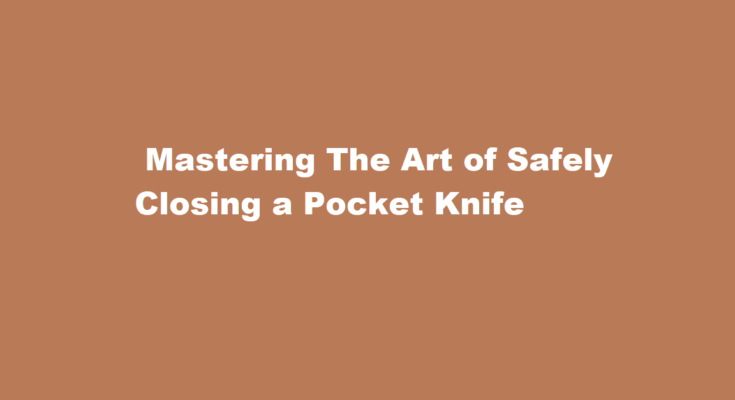Introduction
Pocket knives are versatile tools that have been a part of human culture for centuries. Whether you use a pocket knife for everyday tasks, outdoor adventures, or emergency situations, it’s crucial to know how to safely and efficiently close it. Closing a pocket knife may seem like a straightforward task, but doing it improperly can lead to accidents and injuries. In this article, we will explore the various types of pocket knives and provide a step-by-step guide on how to close them safely.
Types of Pocket Knives
Before we delve into the closing techniques, it’s important to understand the different types of pocket knives. There are various designs and mechanisms, but we can categorize them into two primary categories
1. Slip Joint Knives: These are traditional folding knives with a simple, non-locking design. Slip joint knives have a backspring that allows the blade to fold into the handle but doesn’t lock it in place. This design relies on tension to keep the knife open or closed.
2. Locking Knives: Locking knives come with mechanisms that lock the blade into position, ensuring it doesn’t accidentally fold while in use. Common locking mechanisms include liner locks, frame locks, and lockback systems.
Closing a Slip Joint Knife
Closing a slip joint knife involves carefully applying pressure to the blade to release it from the open position and then folding it into the handle. Follow these steps to close a slip joint knife safely
1. Maintain a secure grip: Hold the handle firmly with one hand while keeping your fingers away from the blade’s edge.
2. Locate the nail nick or groove: Most slip joint knives feature a nail nick or groove on the blade. This is the portion you need to push or apply pressure to in order to close the knife.
3. Apply gentle pressure: With your thumb, push the nail nick or groove gently towards the handle. This action should release the blade from its open position.
4. Fold the blade: Once the blade is disengaged, carefully fold it back into the handle. Keep your fingers away from the blade’s path to avoid accidents.
5. Check for a secure closure: After closing the knife, double-check that the blade is securely in the handle and won’t accidentally open.
Closing a Locking Knife
Locking knives typically require a more specific technique to safely close. Here’s how to close a locking knife
1. Unlock the blade: Identify the locking mechanism on your knife, which may be a liner lock, frame lock, or lockback. Most locking knives have a visible mechanism that must be disengaged to fold the blade.
2. Disengage the lock: Depending on your knife’s type, you may need to push, slide, or release the locking mechanism. Pay close attention to the specific instructions for your knife.
3. Hold the handle securely: With one hand, maintain a firm grip on the knife’s handle, keeping your fingers away from the blade.
4. Slowly fold the blade: Using your other hand, start to fold the blade back into the handle. Ensure that your fingers are clear of the blade’s path.
5. Double-check the closure: Confirm that the blade is securely locked in the closed position, and the locking mechanism is fully disengaged.
Safety Tips
Closing a pocket knife safely is essential to prevent accidents and injuries. Here are some additional safety tips to keep in mind
1. Always cut away from your body and avoid any body parts in the blade’s path when using a knife.
2. Never try to forcefully close a pocket knife if it’s stuck or jammed. Instead, inspect the knife for any debris or obstructions and remove them carefully.
3. Keep the blade clean and well-maintained to ensure it functions smoothly and securely.
4. When handing a closed pocket knife to someone else, always present it with the closed blade facing the recipient.
5. Be mindful of local laws and regulations regarding the carry and use of pocket knives, as these can vary by region.
FREQUENTLY ASKED QUESTIONS
Why is my pocket knife so hard to close?
The typical causes are: Rust or ageing, goop stuck on the knife, friction and tight hinges.
Is it legal to carry a pocket knife?
Yes, it is illegal in India, but it won’t put you in trouble until and unless someone reports against you that you are carrying a knife with you, or you are found with it in any formal or normal search either by police or by some private person.
Conclusion
Mastering the art of safely closing a pocket knife is a fundamental skill for anyone who uses these versatile tools. Whether you own a slip joint knife or a locking knife, understanding the specific closing technique is crucial for your safety and the longevity of your knife. By following the steps outlined in this article and adhering to safety guidelines, you can confidently handle and close your pocket knife without any mishaps. Always remember that proper knife handling and care are essential for a responsible and enjoyable experience.
Read Also : How to Print Double-Sided – A Step-by-Step Guide



